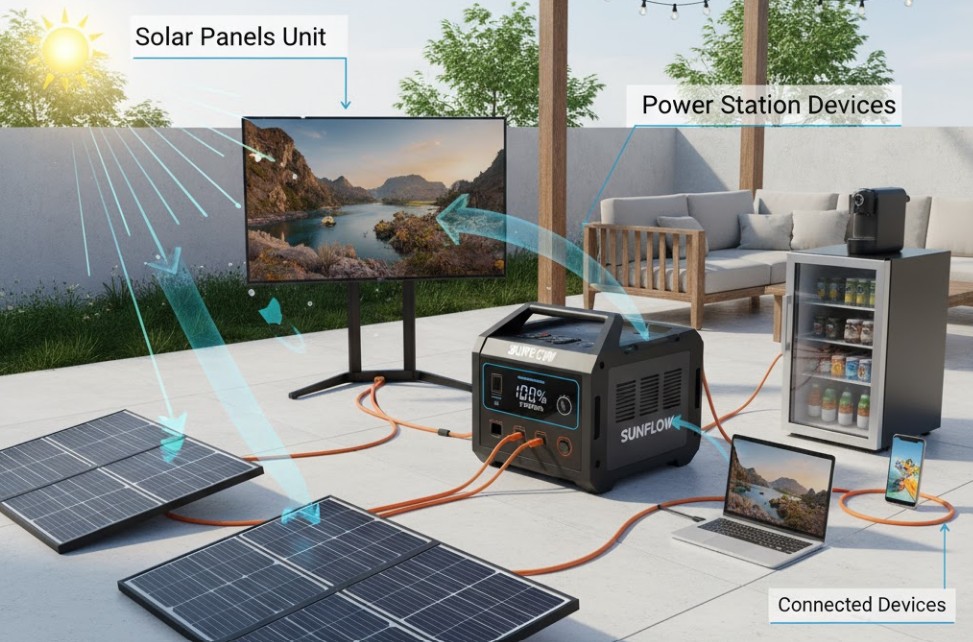In a world increasingly dependent on reliable electricity, the traditional noisy, fume-spewing generator is rapidly being replaced by a cleaner, quieter alternative: the solar generator. More accurately described as a portable power station paired with solar charging capability, this technology represents a significant leap towards energy independence, whether you’re preparing for a home blackout or venturing deep off the grid. However, to truly appreciate this innovation, it’s essential to understand the fundamental question: How Solar Generators Work? This comprehensive guide will pull back the curtain on the technology, component by component, detailing the seamless conversion of sunlight into usable household power.

Defining the Device: What is a Solar Generator?
Despite its common name, a solar generator doesn’t actually *generate* electricity in the same way a traditional combustion engine generator does. Instead of burning fuel (like gasoline, propane, or diesel) to spin a motor and create mechanical energy, a solar generator is essentially an integrated energy storage system that uses the sun’s light to charge a large internal battery. It’s a complete, portable energy package composed of four primary, coordinated components: the solar panels (the collector), the charge controller, the battery (the storage), and the inverter (the converter).
The rise of these devices has revolutionized portable power. If you’re looking for a reliable, silent backup, devices like the best solar generators for home backup are now powerful enough to run essential appliances. For outdoor enthusiasts, options for RV camping make off-grid living easier than ever. The core of this versatility lies in the elegant science of photovoltaics.
The Core Mechanics: How Solar Generators Work, Step-by-Step
Understanding how solar generators work is a journey through four critical stages of energy transformation, storage, and delivery. This process ensures that the diffuse energy from the sun is captured, stabilized, stored, and ultimately converted into the alternating current (AC) power your electronics and appliances require.
Stage 1: Sunlight Capture and DC Generation (The Panels)
The entire operation begins with the solar panels, which are typically made up of multiple photovoltaic (PV) cells. The term “photovoltaic” literally means “light-electricity.”
The Role of the Photovoltaic Effect
At the microscopic level, each PV cell is constructed from layers of semiconducting material, most commonly silicon. This material is engineered into two primary layers: a p-type layer (positive charge) and an n-type layer (negative charge). When photons (particles of light) from the sun strike the solar panel’s surface, they excite electrons within the silicon. These energized electrons are forced to move from the p-type layer to the n-type layer, establishing a continuous flow of electricity. This flow is Direct Current (DC) electricity—the same type of power found in car batteries and small electronic devices. It’s important to note that the efficiency of this process dictates how quickly your battery will charge, making high-quality, efficient panels a critical component of any solar generator setup. The captured power is now ready for the next stage: regulation.
Stage 2: Power Regulation and Conditioning (The Charge Controller)
The DC power generated by the panels is rarely stable or perfectly matched to the needs of the battery. Factors like cloud cover, angle of the sun, and temperature can cause voltage to fluctuate wildly. If this unregulated power were to flow directly into the battery, it could significantly shorten the battery’s lifespan or even cause damage. This is where the charge controller (or solar regulator) steps in, acting as the system’s intelligent gatekeeper.
MPPT vs. PWM Technology
Modern solar generators almost exclusively use advanced Maximum Power Point Tracking (MPPT) charge controllers. Unlike older, less efficient Pulse Width Modulation (PWM) controllers, the **MPPT controller** constantly monitors both the panel’s voltage and the battery’s voltage. Its primary function is to optimize the energy transfer by dynamically adjusting the electrical load to ensure the panels are operating at their maximum power point (the optimal ratio of voltage to current). This can lead to a charging efficiency increase of 15% to 30%, which is crucial for quick recharging, especially in less-than-ideal weather conditions. Once regulated, the stable DC power is safely directed to the battery.
Stage 3: Energy Storage (The Battery Bank)
The heart of any solar generator is the battery bank, where the regulated DC power is stored until it is needed. Without storage, the generator could only be used while the sun is shining, defeating its purpose as a reliable power source.
Lithium’s Dominance in Portable Power
While older, bulkier setups might have relied on Lead-Acid batteries (similar to those mentioned in studies of Direct Current generators), virtually all modern portable solar generators utilize Lithium-ion (Li-ion) or the even safer and longer-lasting Lithium Iron Phosphate (LiFePO4) chemistries. Lithium batteries offer three key advantages:
- High Energy Density: They can store a significant amount of power relative to their size and weight, making the unit truly portable.
- Deep Discharge Capability: They can be regularly drained to a very low state of charge (often 80% to 100% Depth of Discharge or DoD) without significant long-term damage.
- Long Cycle Life: LiFePO4 batteries, in particular, can handle thousands of charge and discharge cycles, providing years of reliable service.
The capacity of this battery bank, measured in Watt-hours (Wh) or Kilowatt-hours (kWh), is the critical factor determining how long the solar generator can run your appliances. More Wh means more runtime before the next recharge.
Stage 4: AC Conversion and Power Delivery (The Inverter)
This final stage is perhaps the most crucial for real-world usability. The power stored in the battery is Direct Current (DC), but almost all standard household appliances—from refrigerators to laptops—run on Alternating Current (AC). The component responsible for this vital transformation is the inverter.
Pure Sine Wave vs. Modified Sine Wave
High-quality solar generators use a Pure Sine Wave (PSW) inverter. The output waveform of this inverter closely mimics the smooth, clean power provided by utility companies. This is essential for protecting sensitive electronics like medical devices, computers, and appliances with delicate motor components (like fridges and fans). Cheaper units may use a Modified Sine Wave (MSW) inverter, which is fine for simple resistive loads (like light bulbs or toasters), but can damage or inefficiently run sophisticated electronics.
The inverter takes the stored 12V, 24V, or 48V DC power and transforms it into 120V (or 240V, depending on region) AC power, delivering it through the familiar electrical outlets (plugs) on the side of the portable power station. This is the final step in answering how solar generators work—the conversion from sunlight to plug-and-play electricity is complete.
The Advantages of Choosing Solar: Silence, Safety, and Sustainability
When comparing a solar generator to its gas-powered counterpart, the benefits extend far beyond simply eliminating fuel costs. The transition to solar represents a conscious choice towards a safer, more sustainable, and dramatically more convenient method of portable power. The fundamental difference lies in the energy source: while a conventional generator requires continuous fuel purchase and combustion, the solar option relies on a perpetual, free energy source: the sun.
The Silent Revolution: Noise and Emissions
Perhaps the most immediate and appreciated benefit of understanding how solar generators work is the resulting silence. Because there are no moving parts involved in the generation of power (no engine combustion or mechanical rotation), a solar unit operates nearly silently. This makes it ideal for use in residential neighborhoods, at campsites, or inside enclosed spaces like homes and garages where running a gas generator would be impossible due to noise regulations and deadly carbon monoxide fumes. The zero-emission aspect is equally critical. A solar generator produces no exhaust, making it a perfectly safe appliance to run indoors during a power outage—a critical safety advantage that a gas generator simply cannot offer.
Maintenance, Longevity, and Ease of Use
Traditional generators require regular oil changes, spark plug replacements, and fuel stabilization. In contrast, the maintenance for a high-quality portable solar generator is minimal, often limited to keeping the unit clean and ensuring the battery remains properly stored. The sophisticated Battery Management System (BMS) within the unit handles all the complex protective functions, overseeing temperature, voltage, and current to maximize the battery’s lifespan. Furthermore, the overall longevity of a system using LiFePO4 batteries often surpasses the operational lifespan of a gas engine, making the long-term cost of ownership highly competitive, particularly when considering the free nature of the solar “fuel.”
The operational simplicity of these units is another significant advantage. There’s no need to store flammable fuel, deal with pull-starts, or manage complex choke settings. Operation is typically as simple as pressing a power button. This makes solar generators accessible to virtually anyone, regardless of technical expertise, providing instantaneous, reliable power when needed most. For emergency preparedness, this ease of use can be life-changing.
Sizing and Selection: Matching Power to Needs
Choosing the right unit requires an understanding of two main specifications, both directly related to how solar generators work—Capacity and Output Power. Understanding these metrics is the difference between purchasing a unit that can only charge a phone and one that can power an entire small cabin.
Capacity (Wh) vs. Output Power (W)
The Watt-hour (Wh) rating (e.g., 1000Wh) dictates the total amount of energy the battery can store. This is the runtime factor. A 1000Wh battery can run a 100W device for 10 hours. Conversely, the Watt (W) rating (e.g., 2000W) dictates the maximum power the inverter can output at any given moment. This is the appliances-at-once factor. If your microwave draws 1500W, your generator must have an output rating higher than 1500W to run it. When looking for the best solar powered generators, carefully weigh both of these specifications against your intended application.
For example, a camper looking to run LED lights and charge devices only needs a unit with a few hundred Wh of capacity and a low W rating. However, a homeowner planning to run a refrigerator and a small sump pump during an outage will need a unit with at least 2000Wh of capacity and a high surge wattage rating to handle the initial startup power demanded by motor-driven appliances. This careful calculation ensures that the investment aligns perfectly with the power requirements, maximizing the benefit of the solar generator.
Advanced Features and the Future of Portable Power
The technology behind solar generators is rapidly evolving, moving beyond simple battery storage to incorporate smart features and enhanced power delivery methods. These advancements make today’s portable power stations more versatile, safer, and user-friendly than previous generations.
Smart Charging and Efficiency: Pass-Through and Hybrid Systems
One of the most valuable features in modern units is pass-through charging. This capability allows the user to power devices from the solar generator’s outputs while the unit itself is simultaneously being charged by solar panels or an AC wall outlet. This effectively turns the portable unit into a seamless Uninterruptible Power Supply (UPS) for essential electronics, ensuring zero downtime. Furthermore, many high-end solar generators now support hybrid charging, meaning they can accept input from multiple sources—solar panels and a wall plug—at the same time, drastically reducing the total recharge time. This is especially useful for quickly topping up the unit before a predicted power outage or trip.
Beyond the Silicon: Emerging Panel Technology
While most portable systems rely on rigid or foldable monocrystalline silicon panels (known for their high efficiency and compact size), the future is moving towards highly flexible and lightweight thin-film solar technology. This allows the panels to be easily integrated into backpacks, tents, or curved RV roofs, further enhancing the portability and off-grid utility of the solar generator system. As efficiency increases and costs drop, these flexible materials will make solar charging even more accessible for everyday users, cementing the solar generator’s role as the go-to solution for off-grid power. This continuous innovation ensures that the process of how solar generators work is only going to become more streamlined and efficient over time.
Another area of immense progress is the integration of smart technology. Many contemporary units include Wi-Fi or Bluetooth connectivity, allowing users to monitor charge status, power input, and output remotely via a smartphone app. This level of granular control and data reporting helps users maximize the efficiency of their setup, optimizing panel placement and managing power draw for maximum runtime. For large-capacity solar generators used for extended home backup, this connectivity is becoming an essential feature, moving these devices from simple batteries to intelligent energy management hubs.
Safety and Environmental Impact
The shift to solar power is not just about convenience; it’s a powerful move toward environmental stewardship. By utilizing a solar generator, individuals reduce their reliance on fossil fuels, directly contributing to a lower carbon footprint. The environmental advantages are clear: no greenhouse gas emissions during operation and a reduced dependency on centralized power grids often fueled by coal or natural gas.
Built-in Protection: The Battery Management System (BMS)
Modern solar generators are inherently safer than older battery technologies due to the integration of a sophisticated Battery Management System (BMS). The BMS is a critical electronic component that monitors the battery’s health, preventing common issues that plagued earlier rechargeable devices. Key safety functions of the BMS include:
- Over-Voltage Protection: Prevents the battery from being overcharged, which could lead to overheating.
- Under-Voltage Protection: Prevents the battery from being drained too low, which would irreversibly damage its capacity.
- Temperature Control: Monitors the battery temperature and shuts down charging or discharging if the temperature exceeds safe operating limits.
- Short-Circuit Protection: Immediately cuts power flow in the event of a short circuit.
This internal intelligence ensures the unit operates within its safest parameters, providing peace of mind whether the generator is used for a weekend camping trip or as a critical home backup system. Moreover, the shift to Lithium Iron Phosphate (LiFePO4) batteries, which are chemically more stable and less prone to thermal runaway than other lithium chemistries, further enhances the overall safety profile of the modern solar generator.
The minimal environmental footprint, combined with robust safety features, positions the solar generator as a responsible and reliable energy choice for the 21st century consumer. It represents a practical, decentralized approach to power generation that benefits both the user and the planet.
Final Thoughts
The journey from a ray of sunlight to household-ready electricity is a testament to clever engineering and the elegance of physics. The answer to how solar generators work is not a single action but a seamless, four-stage process: light capture via photovoltaics, intelligent regulation via a charge controller, high-density storage in a modern lithium battery, and safe conversion via a pure sine wave inverter. These devices embody the future of accessible, portable, and clean power.
For individuals seeking true energy independence—be it for sustainable off-grid living, emergency preparedness, or just quiet outdoor enjoyment—the solar generator is the definitive, eco-friendly solution. As technology continues to improve, these quiet, clean powerhouses will only become more efficient, more powerful, and more integrated into our everyday lives, solidifying their role as essential tools in the modern world.
Amranul is a highly experienced product review writer with a passion for helping readers make smart, informed purchasing decisions. Since 2018, he has specialized in thoroughly researching and analyzing a wide range of products to deliver honest, in-depth reviews. Amranul combines technical accuracy with clear, engaging writing to break down complex product features and highlight true user value. Look for his reviews to find reliable information and expert insights you can trust before you buy!





